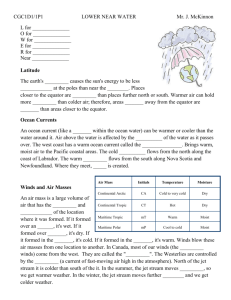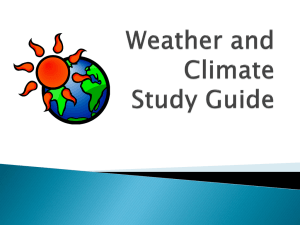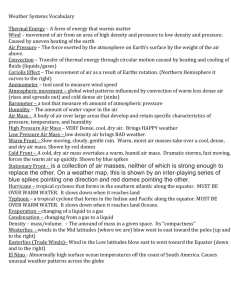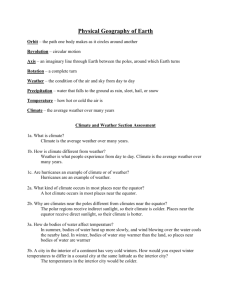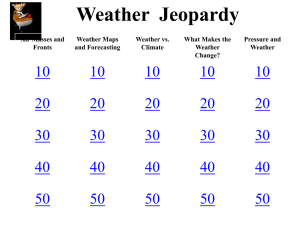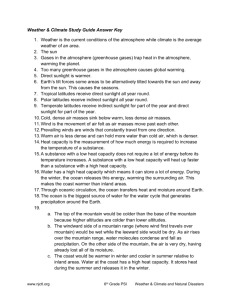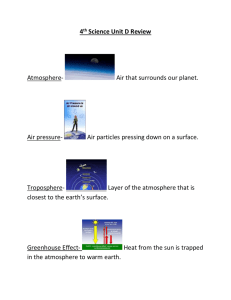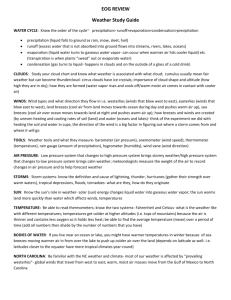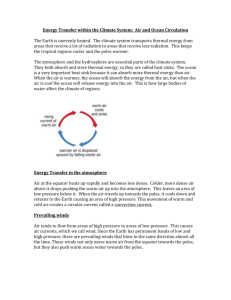Weather and Climate Study Guide - The Short Report
advertisement
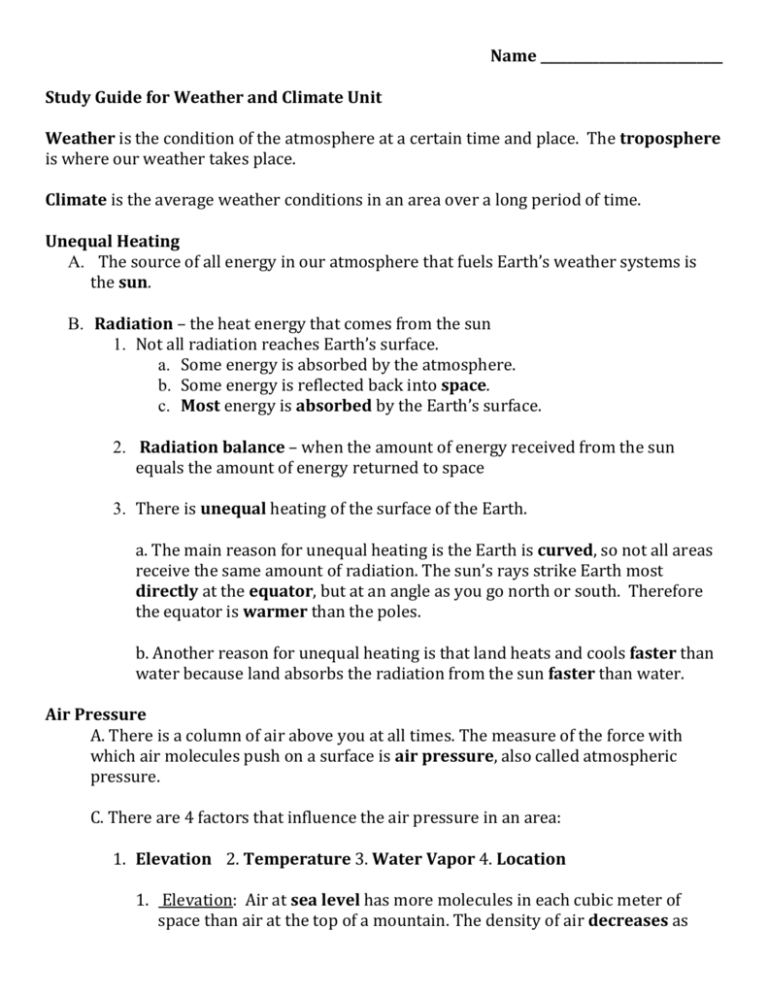
Name ____________________________ Study Guide for Weather and Climate Unit Weather is the condition of the atmosphere at a certain time and place. The troposphere is where our weather takes place. Climate is the average weather conditions in an area over a long period of time. Unequal Heating A. The source of all energy in our atmosphere that fuels Earth’s weather systems is the sun. B. Radiation – the heat energy that comes from the sun 1. Not all radiation reaches Earth’s surface. a. Some energy is absorbed by the atmosphere. b. Some energy is reflected back into space. c. Most energy is absorbed by the Earth’s surface. 2. Radiation balance – when the amount of energy received from the sun equals the amount of energy returned to space 3. There is unequal heating of the surface of the Earth. a. The main reason for unequal heating is the Earth is curved, so not all areas receive the same amount of radiation. The sun’s rays strike Earth most directly at the equator, but at an angle as you go north or south. Therefore the equator is warmer than the poles. b. Another reason for unequal heating is that land heats and cools faster than water because land absorbs the radiation from the sun faster than water. Air Pressure A. There is a column of air above you at all times. The measure of the force with which air molecules push on a surface is air pressure, also called atmospheric pressure. C. There are 4 factors that influence the air pressure in an area: 1. Elevation 2. Temperature 3. Water Vapor 4. Location 1. Elevation: Air at sea level has more molecules in each cubic meter of space than air at the top of a mountain. The density of air decreases as altitude increases. Atmospheric pressure is greatest near Earth’s surface and decreases as you move upward away from sea level. 2. Temperature: The colder the air, the more the molecules move toward one another. Colder air is more dense. More dense air pushes down and has a higher air pressure than warm air. The warmer the air, the more the molecules move apart. Warmer air is less dense. Less dense air rises upward and has lower air pressure than colder air. 3. Water Vapor: More water vapor in air has less air pressure because part of the space is being taken up by water; therefore there are fewer air molecules per cubic meter of space available to push down. The most important function of the ocean is giving off water vapor into the atmosphere. Wind 4. Location: Air closer to the poles is colder and more dense than air near the equator. Therefore there is more pressure near the poles than at the equator. Places that have similar latitudes (distance from equator) most likely have similar climates. Air moves in large, circular patterns called convection cells. A. Differences in air pressure cause wind. Winds occur because air tends to move from regions of higher air pressure to regions of lower air pressure. 1. As warm air becomes less dense it rises. (low pressure) 2. The colder, more dense air pushes down (high pressure) and rushes in to take the rising, warm air’s place. 3. Winds are named from where they started or came from. B. Local winds – temporary winds that blow in an area and are produced by temperature differences caused by local geographical features Ex: Sea and Land breezes 1. Sea Breezes – a. Land heats up during the day b. Air over land gets warmer than air over water c. warm air over land rises, while cooler, more dense air from over water rushes in to take its place Draw a sea breeze here: Sea Draw a land breeze here: Land Sea Land 2. Land Breeze a. Land cools down at night b. Air over land gets cooler than air over water c. Warmer air over ocean rises while cooler, more dense air from over land rushes in to take its place (Example: Before sunrise on the beach, air over water is warmer than air over land.) C. Global Winds – blow almost constantly in every direction 1. Air above the poles is very cold (higher density and higher pressure) 2. Air above the equator is warmer (less density and lower pressure) 3. The lower pressure warm air rises and the higher pressure cold air sinks and rushes toward the lower pressure areas (equator). 4. The rising, low pressure air at the equator is pushed toward the poles creating global winds 5. Coriolis Effect – the rotation of the Earth causes the wind paths to curve to the left or right. D. Jet stream - fast moving, narrow belt of wind that has a great impact on changing weather conditions because it determines major air movements. Air Masses Air mass - large body of air that gets its temperature and humidity from the land or water over which it forms Warm Wet Maritime tropical Dry Continental tropical Cold Maritime polar Continental polar The cause of changes in the weather is when air masses move and meet. Fronts Front - boundary between 2 different air masses. Fronts usually bring some type of precipitation. a. Cold front – rapidly moving cold air overtakes the slower moving warm air; The warm air quickly rises allowing water vapor to condense. Thunderstorms and severe weather are common at these fronts. (Draw a picture of a cold front here.) On a weather map a cold front is represented by blue triangles. b. Warm front - warmer air slowly moves over colder air and replaces it; Leads to long periods of steady rain or snow. (Draw a picture of a warm front here.) On a weather map a warm front is represented by red semi-circles. c. Stationary front - a cold front and a warm front meet, and neither can move the other out of the way; creates days and days of the same weather (rain or dry spells). (Draw a picture of a stationary front here.) On a weather map a stationary front is represented by alternating red semi-circles and blue arrows pointing in opposite directions. d. Occluded front – a warm air mass is trapped between a cool air mass and a cold air mass. The warm air is cut off from the surface. This leads to heavy rain. (Draw an occluded front here.) On a weather map, an occluded front is represented by purple semi- circles and arrows pointing in the SAME direction. Pressure Systems a. Low Pressure Systems 1) Winds blow into low pressure areas 2) Warm, moist air will rise, causing cloud formation 3) Weather is usually cloudy or stormy. Cloudy nights can be warmer than clear nights because clouds trap heat absorbed by Earth during the daylight hours. b. High Pressure Systems 1) Winds blow away from high pressure areas 2) Sinking motion of air makes it difficult for clouds to form 3) Weather is usually clear and sunny. Severe Weather 1. Thunderstorms are brought by cumulonimbus clouds. 2. Tornadoes are violent, whirling winds that form over land. 3. Hurricanes are large, swirling storms that form over the ocean. They are the most powerful storms. Warm, moist air must be present for a hurricane to develop. Resources Petroleum is an example of a nonrenewable resource. Biomass is an example of a renewable resource/alternative to fossil fuels. Alternative fuels are important because fossil fuels are not renewable, and we need other choices for energy.

